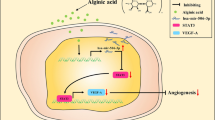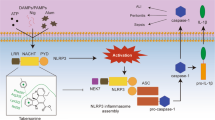Abstract
Citrinin derivatives have been found to have various pharmacological activities, such as anti-inflammatory, anti-tumor, and antioxidant effects. Dicitrinone G (DG) was a new citrinin dimer isolated from marine-derived fungus Penicillium sp. GGF 16-1-2 which has potential activity. Here, we aim to investigate whether DG has anti-pancreatic cancer activity. In xenograft tumor model, 2 × 106 BXPC-3 cells were injected into the hind flank of NU/NU nude mice by subcutaneously for 2 weeks followed by treating with DG (0.25, 0.5, 1 mg/kg) and 5-FU (30 mg/kg) for 4 weeks. Tumor volume and weight were measured, and the expression of CD31, IL-18, NLRP3, and Caspase-1 in tumor tissue were detected. In vitro, HUVECs were treated with conditioned medium (CM) derived from BXPC-3 cells, the effects of DG on angiogenesis were detected by tube formation and western blot analysis. In vivo studies showed that the tumor growth and angiogenesis were greatly suppressed. The tumor weight inhibition rates of DG and 5-FU groups were about 42.36%, 38.94%, 43.80%, and 31.88%. Furthermore, the expression of CD31 and Caspase-1 were decreased. In vitro, CM derived from BXPC-3 cells which treated with DG could inhibit the tube formation and expression of pro-angiogenic NICD in HUVECs. Our study suggests that DG could suppress angiogenesis via the NLRP3/IL-18 pathway and may have the potential to inhibit tumor development.
Graphical abstract







Similar content being viewed by others
References
Chen W, Zheng R, Baade PD et al (2016) Cancer statistics in China, 2015. CA Cancer J Clin 66:115–132. https://doi.org/10.3322/caac.21338
Siegel RL, Miller KD, Jemal A (2020) Cancer statistics, 2020. CA Cancer J Clin 70:7–30. https://doi.org/10.3322/caac.21590
Torphy RJ, Fujiwara Y, Schulick RD (2020) Pancreatic cancer treatment: better, but a long way to go. Surg Today 50:1117–1125. https://doi.org/10.1007/s00595-020-02028-0
Kanugula AK, Adapala RK, Jamaiyar A et al (2021) Endothelial TRPV4 channels prevent tumor growth and metastasis via modulation of tumor angiogenesis and vascular integrity. Angiogenesis 24:647–656. https://doi.org/10.1007/s10456-021-09775-9
Hao F, Zhimian S, Yanhu L et al (2022) Rare carbon-bridged citrinin dimers from the starfish-derived symbiotic fungus Penicillium sp. GGF16-1-2. Mar Drugs 20:443
Zhu Y, Ouyang Z, Du H et al (2022) New opportunities and challenges of natural products research: when target identification meets single-cell multiomics. Acta Pharm Sin B 12:4011–4039. https://doi.org/10.1016/j.apsb.2022.08.022
Park SC, Julianti E, Ahn S et al (2019) Phenalenones from a marine-derived fungus Penicillium Sp. Mar Drugs 17:176. https://doi.org/10.3390/md17030176
Galdiero MR, Marone G, Mantovani A (2018) Cancer inflammation and cytokines. Cold Spring Harb Perspect Biol 10:a028662. https://doi.org/10.1101/cshperspect.a028662
Koliaraki V, Prados A, Armaka M et al (2020) The mesenchymal context in inflammation, immunity and cancer. Nat Immunol 21:974–982. https://doi.org/10.1038/s41590-020-0741-2
Aoe M, Ueno-Iio T, Shibakura M et al (2017) Lavender essential oil and its main constituents inhibit the expression of TNF-alpha-induced cell adhesion molecules in endothelial cells. Acta Med Okayama 71:493–503. https://doi.org/10.18926/AMO/55586
Todoric J, Antonucci L, Karin M (2016) Targeting inflammation in cancer prevention and therapy. Cancer Prev Res 9:895–905. https://doi.org/10.1158/1940-6207.CAPR-16-0209
Esmailbeig M, Ghaderi A (2017) Interleukin-18: a regulator of cancer and autoimmune diseases. Eur Cytokine Netw 28:127–140. https://doi.org/10.1684/ecn.2018.0401
Tezcan G, Garanina EE, Alsaadi M et al (2020) Therapeutic potential of pharmacological targeting NLRP3 inflammasome complex in cancer. Front in immunol 11:607881. https://doi.org/10.3389/fimmu.2020.607881
Zhang M, Shi Z, Peng X et al (2023) NLRP3 inflammasome-mediated pyroptosis induce notch signal activation in endometriosis angiogenesis. Mol Cell Endocrinol 574:111952. https://doi.org/10.1016/j.mce.2023.111952
Fan H, Shi ZM, Lei YH et al (2022) Rare carbon-bridged citrinin dimers from the starfish-derived symbiotic fungus Penicillium sp. GGF16-1-2. Mar Drugs 20:433. https://doi.org/10.3390/md20070443
Das S, Shapiro B, Vucic EA et al (2020) Tumor cell-derived il1beta promotes desmoplasia and immune suppression in pancreatic cancer. Can Res 80:1088–1101. https://doi.org/10.1158/0008-5472.CAN-19-2080
Bukowski K, Kciuk M, Kontek R (2020) Mechanisms of multidrug resistance in cancer chemotherapy. Int J Mol Sci 21:3233. https://doi.org/10.3390/ijms21093233
de Oliveira Filho JWG, Andrade T, de Lima RMT et al (2021) Citrinin against breast cancer: a cytogenotoxicological study. Phytother Res 35:504–516. https://doi.org/10.1002/ptr.6830
Sun MH, Li XH, Xu Y et al (2020) Citrinin exposure disrupts organelle distribution and functions in mouse oocytes. Environ Res 185:109476. https://doi.org/10.1016/j.envres.2020.109476
Aydin Y, Orta Yilmaz B, Yildizbayrak N et al (2021) Evaluation of citrinin-induced toxic effects on mouse sertoli cells. Drug Chem Toxicol 44:559–565. https://doi.org/10.1080/01480545.2019.1614021
Dumitrescu T, Uscatu CD, Alexandru DO et al (2015) Correlations between intratumoral microvessel density and histopathological type or neoadjuvant radiotherapy for rectal carcinoma. Curr Health Sci J 41:152–157. https://doi.org/10.12865/CHSJ.41.02.10
Li Z, Shi L, Li X et al (2021) RNF144A-AS1, a TGF-beta1- and hypoxia-inducible gene that promotes tumor metastasis and proliferation via targeting the miR-30c-2–3p/LOX axis in gastric cancer. Cell Biosci 11:177. https://doi.org/10.1186/s13578-021-00689-z
Yang XM, Han HX, Sui F et al (2010) Slit-Robo signaling mediates lymphangiogenesis and promotes tumor lymphatic metastasis. Biochem Biophys Res Commun 396:571–577. https://doi.org/10.1016/j.bbrc.2010.04.152
Wang M, Li B, Sun H et al (2019) Correlation study between dual source CT perfusion imaging and the microvascular composition of solitary pulmonary nodules. Lung Cancer 130:115–120. https://doi.org/10.1016/j.lungcan.2019.02.013
Wang WQ, Liu L, Xu HX et al (2013) Intratumoral alpha-SMA enhances the prognostic potency of CD34 associated with maintenance of microvessel integrity in hepatocellular carcinoma and pancreatic cancer. PLoS ONE 8:e71189. https://doi.org/10.1371/journal.pone.0071189
Lu L, Yan S, Chen M et al (2021) Diagnostic values of dermatoscopy and CD31 expression in cutaneous lymphangioma circumscriptum. Front Med 8:738815. https://doi.org/10.3389/fmed.2021.738815
Korbel C, Gerstner MD, Menger MD et al (2018) Notch signaling controls sprouting angiogenesis of endometriotic lesions. Angiogenesis 21:37–46. https://doi.org/10.1007/s10456-017-9580-7
Geng Y, Fan J, Chen L et al (2021) A notch-dependent inflammatory feedback circuit between macrophages and cancer cells regulates pancreatic cancer metastasis. Cancer Res 81:64–76. https://doi.org/10.1158/0008-5472.CAN-20-0256
Wang H, Tian Y, Wang J et al (2013) Inflammatory cytokines induce notch signaling in nucleus pulposus cells: implications in intervertebral disc degeneration. J Biol Chem 288:16761–16774. https://doi.org/10.1074/jbc.M112.446633
Carta S, Penco F, Lavieri R et al (2015) Cell stress increases ATP release in NLRP3 inflammasome-mediated autoinflammatory diseases, resulting in cytokine imbalance. Proc Natl Acad Sci U S A 112:2835–2840. https://doi.org/10.1073/pnas.1424741112
Kobori T, Hamasaki S, Kitaura A et al (2018) Interleukin-18 amplifies macrophage polarization and morphological alteration, leading to excessive angiogenesis. Front Immunol 9:334. https://doi.org/10.3389/fimmu.2018.00334
Su CM, Wang IC, Liu SC et al (2017) Hypoxia induced mitogenic factor (HIMF) triggers angiogenesis by increasing interleukin-18 production in myoblasts. Sci Rep 7:7393. https://doi.org/10.1038/s41598-017-07952-9
Couchie D, Vaisman B, Abderrazak A et al (2017) Human plasma thioredoxin-80 increases with age and in ApoE(-/-) Mice induces inflammation, angiogenesis, and atherosclerosis. Circulation 136:464–475. https://doi.org/10.1161/CIRCULATIONAHA.117.027612
Acknowledgements
We thank all the participants for their interest on this study.
Funding
This work was financially supported the Special Project for Marine Economic Department of Natural Resources of Guangdong Province (GDNRC[2021]48, GDNRC[2023]37 and GDNRC [2020]039); the National Natural Science Foundation of China (No. 82274130, No. 82273845 and No. 81741160); National Key Research and Development Program of China (2017YFC1700400 and 2017YFC1700404); Guangdong Natural Science Funds for Distinguished Young Scholars (20181B030306027); Major Program of Science and Technology Program of Guangzhou (202103000044); Special Program for Key Fields of Colleges and Universities of Guangdong (2021ZDZX2041) and Wuhan Health Research Fund (WZ20Y03); Hubei Provincial Natural Science Foundation of China (2021CFB424).
Author information
Authors and Affiliations
Contributions
ZS, MZ, HF, YC, SD, FZ, JL, JJ, YL, and QC performed the experiments and collected the data; ZS and YC analyzed the data; WW, CZ, and YC discussed the results and commented on the manuscript; YC designed the study and wrote the manuscript; BW corrected the grammar mistakes in the revised manuscript, ZS, MZ, HF contributed equally to this study. All authors have read and agreed to the version of the manuscript.
Corresponding authors
Ethics declarations
Conflict of interest
The authors have no conflicts of interest to declare.
Additional information
Publisher's Note
Springer Nature remains neutral with regard to jurisdictional claims in published maps and institutional affiliations.
Supplementary Information
Below is the link to the electronic supplementary material.
Rights and permissions
Springer Nature or its licensor (e.g. a society or other partner) holds exclusive rights to this article under a publishing agreement with the author(s) or other rightsholder(s); author self-archiving of the accepted manuscript version of this article is solely governed by the terms of such publishing agreement and applicable law.
About this article
Cite this article
Shi, Z., Zhang, M., Fan, H. et al. The marine Penicillium sp. GGF16-1-2 metabolite dicitrinone G inhibits pancreatic angiogenesis by regulating the activation of NLRP3 inflammasome. J Nat Med 78, 78–90 (2024). https://doi.org/10.1007/s11418-023-01749-z
Received:
Accepted:
Published:
Issue Date:
DOI: https://doi.org/10.1007/s11418-023-01749-z




